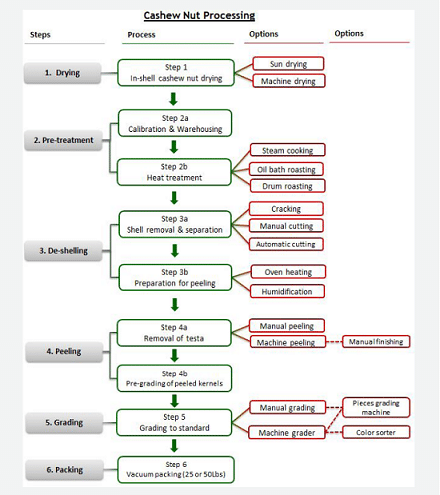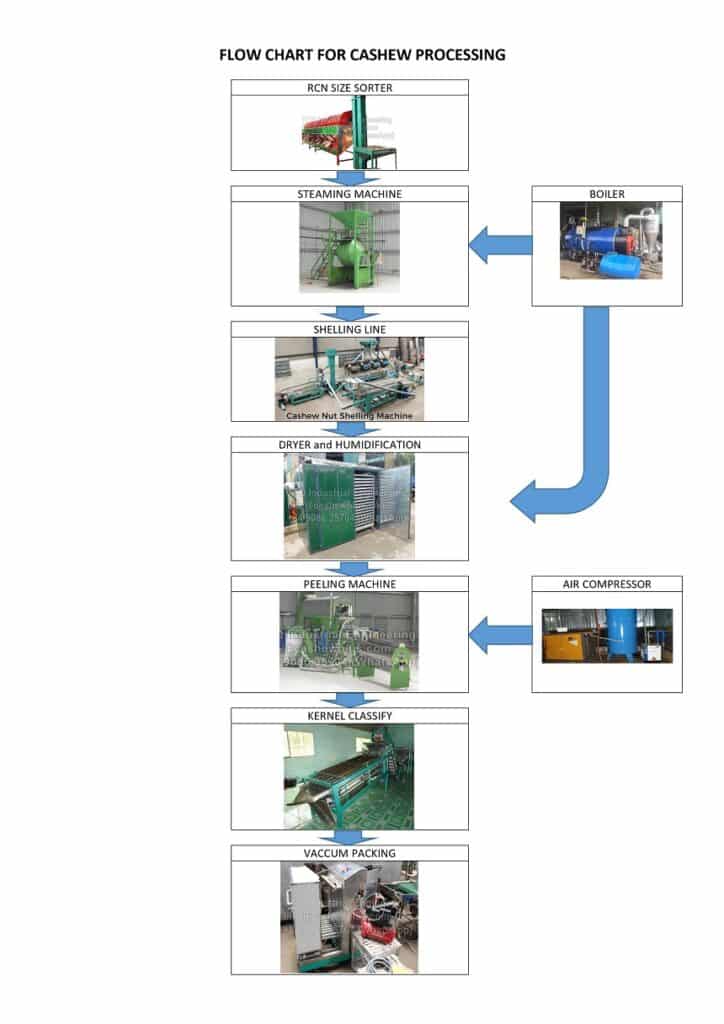
TTQ Co. Ltd.
Cashew Manufacturing Process | Cashew Processing | Cashews Process
Discover the complete cashew manufacturing process – from seed to finished product. Learn about different stages of production, including soaking, drying, shelling, roasting and packing. Get expert advice on how to optimize each step for maximum efficiency and quality.
The cashew manufacturing process involves several stages from harvesting to the final packaging of cashew kernels. This comprehensive report aims to provide an overview of the cashew manufacturing process, highlighting each stage and its significance in producing high-quality cashew products.
Cashew nuts are harvested manually by plucking the cashew apples from the trees. Harvesters carefully handle the cashew apples to avoid damaging the nuts inside. Timing is crucial, and the harvest usually takes place during the dry season when the cashew nuts are ripe.

Cashew Apple Removal:
After harvesting, the outer shells of the cashew apples, known as cashew apple or drupe, are removed. This can be done manually or with the help of cashew nut fruit separators or de-husking machines. The goal is to separate the cashew nut from the fruit without causing damage to the nut kernel.
Drying:
The cashew nuts, still encased in their inner shells, are spread out in a single layer to dry. Drying is essential to reduce moisture content and prevent mold or fungal growth. This can be achieved by sun drying or using mechanical drying methods.
Cashew Apple Removal:
After harvesting, the outer shells of the cashew apples, known as cashew apple or drupe, are removed. This can be done manually or with the help of cashew nut fruit separators or de-husking machines. The goal is to separate the cashew nut from the fruit without causing damage to the nut kernel.
Roasting:
Roasting is an optional step that enhances the flavor and aroma of cashew nuts. The dried cashew nuts are subjected to controlled heat, which brings out their natural flavors and improves shelf life. Roasting can be done using specialized cashew roasting machines or ovens.
Shelling:
Shelling is the process of removing the outer shell or testa of the cashew nut to reveal the edible kernel. Cashew nuts have a unique shape, and their shells are extremely hard. Shelling can be done manually or with the help of automated cashew nut shelling machines. The objective is to crack the shell without damaging the kernel inside.
Grading and Sorting:
Grading and sorting involve categorizing cashew kernels based on their size, color, and quality. This is typically done using specialized machinery that separates cashew kernels into different grades or categories. Grading ensures uniformity in the final product and facilitates quality control.
Packaging:
The final stage of the cashew manufacturing process is packaging. Cashew kernels are carefully packed in various packaging materials, such as vacuum-sealed bags, cans, or cartons, to maintain freshness and prevent moisture absorption. Proper packaging ensures that cashew kernels reach consumers in optimal condition.
Quality Control:
Throughout the manufacturing process, quality control measures are implemented to ensure that only high-quality cashew kernels are produced. This includes monitoring factors such as moisture content, kernel integrity, color, and taste. Regular inspections, testing, and adherence to quality standards are essential to maintain product consistency and meet customer expectations.
By-Products:
The cashew manufacturing process also generates by-products such as cashew apple juice and cashew shell oil. Cashew apple juice can be processed into beverages, jams, or syrups, while cashew shell oil is used in various industries, including food, pharmaceuticals, and cosmetics.
The cashew manufacturing process involves several stages, each contributing to the production of high-quality cashew kernels. From harvesting to packaging, careful attention to detail and adherence to quality control measures are crucial. Automation and mechanization have played a significant role in improving efficiency and consistency in the cashew manufacturing industry. The process ensures that cashew kernels reach consumers with their distinct flavor, nutritional benefits, and quality intact.
The steps in cashew production can be summarized as follows:
Cultivation: Cashew trees are planted and cultivated in suitable growing regions. They require well-drained soil, tropical or subtropical climates, and adequate sunlight.
Flowering and Fruit Development: Cashew trees produce flowers, which are pollinated by insects or wind. The flowers then develop into cashew apples, which are fleshy fruits containing the cashew nut.
Harvesting: Cashew nuts are harvested by carefully removing the cashew apples from the trees. Harvesters must handle the cashew apples with care to avoid damaging the nuts inside.
Dehusking: The outer shell or cashew apple is removed from the harvested cashew nuts, typically using manual or mechanical methods.
Drying: The dehusked cashew nuts are spread out in a single layer to dry, reducing their moisture content and preventing mold or fungal growth.
Sorting and Grading: The dried cashew nuts are sorted based on size, color, and quality. This helps ensure uniformity and facilitates quality control.
Roasting (optional): Cashew nuts can undergo a roasting process to enhance their flavor, aroma, and shelf life.
Shelling: The inner shell or testa of the cashew nut is removed, revealing the edible kernel inside. Shelling can be done manually or with the help of automated cashew nut shelling machines.
Cleaning and Packaging: The cashew kernels undergo a cleaning process to remove any shell fragments, dust, or impurities. They are then packaged in various materials to maintain freshness and quality.
Storage and Distribution: Cashew kernels are stored in appropriate conditions to preserve their quality and nutritional properties. They are then distributed to various markets and consumers.
The main method of processing cashew nuts involves the following steps:
Dehusking: The outer shell or cashew apple is removed from the harvested cashew nuts, typically using manual or mechanical methods.
Drying: The dehusked cashew nuts are spread out in a single layer to dry, reducing their moisture content and preventing mold or fungal growth.
Sorting and Grading: The dried cashew nuts are sorted based on size, color, and quality to ensure uniformity and facilitate quality control.
Roasting (optional): Cashew nuts can undergo a roasting process to enhance their flavor, aroma, and shelf life.
Shelling: The inner shell or testa of the cashew nut is removed, revealing the edible kernel inside. Shelling can be done manually or with the help of automated cashew nut shelling machines.
Cleaning and Packaging: The cashew kernels undergo a cleaning process to remove any shell fragments, dust, or impurities. They are then packaged in various materials to maintain freshness and quality.
The raw material for cashew processing is the cashew nut, which is the seed of the cashew tree (Anacardium occidentale). The cashew nut is found inside the cashew apple, which is a fleshy fruit that develops from the flowering of the cashew tree. The cashew nut is the main component that undergoes processing to produce various cashew products.
When harvested, the cashew nut is encased in a hard outer shell or pericarp, which is removed during the processing. The cashew nut itself consists of different layers, including the outer shell (testa) and the inner kernel, which is the edible part.
It's important to note that the cashew apple, although part of the raw material during harvesting, is not typically processed extensively. It is often consumed fresh or used to make beverages, jams, or other products, while the focus of cashew processing is primarily on the cashew nut.
Manually processing cashews involves several steps to remove the outer shell and prepare the cashew nuts for consumption. Here is a general overview of the manual cashew processing method:
Dehusking: The first step is to remove the outer shell or cashew apple from the cashew nut. This is typically done by using a sharp knife or a hand-held nutcracker to carefully cut or crack open the shell. The shell is gently pried open, taking care not to damage the kernel inside.
Drying: Once the cashew nuts are dehusked, they need to be dried to reduce their moisture content. The cashews are spread out in a single layer on trays or drying racks in a well-ventilated area away from direct sunlight. They are left to air dry for several days until the moisture content reaches an optimal level (usually around 8-10%).
Sorting and Grading: After drying, the cashew nuts are sorted based on size, color, and quality. This is typically done by hand, where workers visually inspect each cashew nut and separate them into different categories. Sorting ensures uniformity and helps maintain quality standards.
Roasting (optional): Roasting is an optional step that can enhance the flavor and aroma of cashew nuts. If desired, the cashews can be roasted in a pan or oven at a controlled temperature. The roasting process helps develop a rich, nutty flavor and improves the shelf life of the cashews.
Shelling: The next step is to remove the inner shell or testa of the cashew nut to reveal the edible kernel inside. This is often the most challenging and time-consuming step in manual processing. It involves carefully cracking the shell using a nutcracker or a specialized tool, while ensuring that the kernel remains intact.
Cleaning and Packaging: Once the cashew kernels are shelled, they undergo a thorough cleaning process to remove any shell fragments, dust, or impurities. This can be done by rinsing the kernels with water or using sieves to separate the debris. After cleaning, the cashew kernels are ready for packaging. They can be stored in airtight containers or sealed bags to maintain freshness and quality.
Cette section doit décrire les besoins de financement de l’entreprise, y compris les coûts de démarrage, le fonds de roulement et les sources potentielles de financement telles que les prêts ou les investissements.
Roasting Process | Shelling Process | Cashew Processing India | Roasted Nut
Cashew manufacturing process pdf
Cashew manufacturing process flow chart
Cashew manufacturing process flow
cashew nut processing pdf
cashew processing in india
preparing raw material, manufacture, exporting, method, manufacturer, processes, machine shelling, machine kernels, cracking machine, robusta screen, arabica screen, white pepper, products move, blog log, february, earth, roasted

